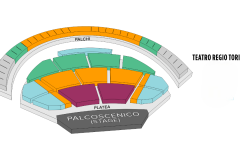La Cenerentola
January 2026 | ||||||
|---|---|---|---|---|---|---|
Mo | Tu | We | Th | Fr | Sa | Su |
La Cenerentola | Gioachino Rossini
With La Cenerentola, ossia La bontà in trionfo, which premiered in 1817, a year after the debut of Il barbiere di Siviglia, Rossini added new sentimental shades to his comic flair that had already brought him success throughout Europe. The fairy tale by Perrault, adapted by Jacopo Ferretti with some variations (most notably the stepmother becoming a stepfather and the glass slipper replaced by a bracelet), gave him the opportunity to tint his crescendos with melancholic nuances and to open up his frantic rhythms to touches of poetry. The result is an opera in which the main characters, Cinderella and Prince Don Ramiro, sing of their feelings with all the fragility of youth, while the antagonists, the stepfather Don Magnifico and the stepsisters, provide a flavorful and grotesque counterpoint, with humor rooted in Neapolitan tradition, yet mindful of the European origins of the Cinderella tale in the land of Basile.
For this ever-engaging opera, the direction is entrusted to Manu Lalli, already acclaimed at the Maggio Musicale Fiorentino in 2024, and the orchestra will be conducted by Antonino Fogliani, one of the most authoritative batons in the bel canto repertoire today. Cinderella will be sung by coloratura soprano Vasilisa Beržanskaya, known for her incredible vocal range. Joining her on stage will be Nico Darmanin, Roberto De Candia, and Carlo Lepore—all guarantees of a musically memorable production.
Synopsis
In this variation of the traditional Cinderella story, the wicked stepmother is replaced by a wicked stepfather, Don Magnifico. The Fairy Godmother is replaced by Alidoro, a philosopher and the Prince's tutor. Cinderella is identified not by her glass slipper but by her bracelet.
Time: Late 18th century – early 19th century
Place: Italy
Act 1
Angelina ("Cenerentola") is forced to work as the maid in the run-down house of her stepfather Don Magnifico. While his two mean, idle daughters, Clorinda and Tisbe, try on their gowns and jewelry, Cenerentola sings a ballad about a king who found his wife among common folk. A beggar comes calling. Clorinda and Tisbe want to send him away, but Cenerentola offers him bread and coffee. Courtiers arrive to announce that Prince Ramiro is looking for the most beautiful girl in the land to be his bride, and is on his way to pay them a visit. Prince Ramiro arrives, disguised as his own valet in order to observe the women without them knowing. He is immediately struck with admiration for Cenerentola and she for him. Cenerentola has to leave when her stepsisters call her. Don Magnifico enters and Ramiro tells him the Prince will arrive shortly. The "prince" is actually Dandini, Ramiro's valet in disguise. The stepsisters arrive and fawn gleefully over Dandini, who invites them to a ball at the Royal palace. Don Magnifico tells Cenerentola that she cannot accompany them to the ball, despite her pleading. Before leaving, Ramiro notices how badly Cenerentola is treated. His tutor, Alidoro, who had been at the house earlier disguised as the beggar, arrives still wearing his rags and asks for Don Magnifico's third daughter. Magnifico denies she is still alive, but when Alidoro is left alone with Cenerentola, he tells her that she will accompany him to the ball. He throws off his beggar's clothes and identifies himself as a member of Prince Ramiro's court, telling her that heaven will reward her pure heart.
The stepsisters and Don Magnifico arrive at Prince Ramiro's palace, with Dandini still posing as the Prince. Dandini offers Magnifico a tour of the wine cellar, hoping to get him drunk. He then disentangles himself from the family and tells Ramiro how stupid and obnoxious the two sisters are. Ramiro is confused since Alidoro had spoken well of one of Magnifico's daughters. Clorinda and Tisbe enter and impatiently pressure Dandini to declare his "princely" choice. Without committing himself, Dandini ponders the question "Whom will the rejected sister marry?" and suggests Ramiro as a possible husband. Believing him to be a mere valet, the two sisters reject Ramiro as a despicable choice and insult him to his face. Alidoro announces the arrival of an unknown, lavishly dressed yet veiled, lady (Cenerentola). All sense something familiar about her and feel they are in a dream but on the verge of being awakened with a shock.
Act 2
Don Magnifico, Clorinda, and Tisbe are in a room of Ramiro's palace. Magnifico frets over the unknown woman who threatens the chance for one of his daughters to marry Prince Ramiro. The three leave and Ramiro enters, smitten with the unknown woman who resembles the girl he had met that morning. He conceals himself as Dandini arrives with Cenerentola and tries to court her. She turns Dandini down politely, telling him that she is in love with his valet. Ramiro steps forth and declares his love for her. She then leaves giving him one of a pair of matching bracelets and saying that if he really cares for her, he will find her. Encouraged by Alidoro, Ramiro calls his men together to begin searching for her. Meanwhile, Dandini confesses to Don Magnifico that he is really Prince Ramiro's valet. Magnifico becomes highly indignant, and Dandini orders him out of the palace.
At Magnifico's house, Cenerentola, once again dressed in rags, is tending the fire and singing her ballad. Magnifico and his daughters return from the ball in a vile mood, and order Cenerentola to prepare their supper. A thunderstorm rages. Dandini suddenly appears at the door to say that Prince Ramiro's carriage has overturned outside and brings him into the house. Cenerentola fetches a chair for the prince and realizes he is Ramiro. He recognizes her bracelet and the couple are reunited. Don Magnifico, Clorinda and Tisbe are furious. Angered by their cruelty to Cenerentola, Ramiro threatens to punish them, but Cenerentola asks him to be merciful. As Cenerentola leaves with her prince, Alidoro thanks heaven for the happy outcome.
In the throne room of Ramiro's palace, Magnifico tries to curry favour with his stepdaughter, the new princess, but she only wants to be acknowledged as his daughter. Cenerentola asks the prince to forgive Magnifico and the two stepsisters. Her father and stepsisters embrace her as she declares that her days of toiling by the fire are over.
Program and cast
Overtitles in italian/english
PLAYFUL MELODRAMA IN TWO ACTS
Music by Gioachino Rossini
Libretto by Jacopo Ferretti
based on from the story Cinderella by Charles Perrault
World première:
Rome, Teatro Valle, 25/01/1817
Antonino Fogliani conductor
Manu Lalli direction
Roberta Lazzeri sets
Gianna Poli costumes
Vincenzo Apicella lighting
Valerio Tiberi taken from
Chiara Casalbuoni assistant to director
Ulisse Trabacchin chorus master
Orchestra and Chorus Teatro Regio Torino
Staging Maggio Musicale Fiorentino
Teatro Regio di Torino
The Teatro Regio di Torino is one of the oldest opera theatres in existence today: its origins date back to 1740, the year in which it opened as a magnificent venue of the Savoy Court. Designed by architect Benedetto Alfieri with innovative criteria, it soon became a destination of the grand tours of the period. After almost two centuries of uninterrupted activity, the old building, a theatre “all’italiana” with five tiers of boxes, was destroyed in a violent fire on the night between 8 and 9 February, 1936.
The fire did not interrupt the programming of the Regio, which continued in other theatres across the city until the opening of the present structure. Unique in all the world for its design, thanks to the genius of architect Carlo Mollino, it was inaugurated in 1973 with I Vespri siciliani by Verdi, in the one and only stage direction of Maria Callas and Giuseppe Di Stefano.
One Theatre, many proposals
The Teatro Regio offers a rich Opera and Ballet Season consisting of numerous operas, ballets and musicals. Together with the main Season there are also many other activities: symphonic-choral and chamber music concerts involving the Orchestra, Chorus and Children’s Chorus of the Teatro Regio; a series of shows staged at the Piccolo Regio Puccini and intended for schools and families; lectures, guided tours, exhibitions and special events realized in collaboration with the City of Torino and other institutions like MITO SettembreMusica. All events that put Teatro Regio at the centre of the cultural and artistic life of Torino, Piemonte and more.
How to arrive
By train
From both of the Torino train stations, Porta Susa and Porta Nuova, the Theatre can be reached by taxi (10 minutes) or on foot (about 20 minutes).
You can find your train to Torino at these internet sites:
Trenitalia
NTV-Italo
GTT-SFM
SNCF-TGV
By car
Depending on where you’re coming from, these are the main routes:
From the north and north-east
Motorway A4 Torino-Milano-Trieste or Motorway A5 Torino-Aosta, in both cases the exit is Corso Giulio Cesare
From the west
Motorway A32 Torino-Bardonecchia, exit Corso Regina Margherita
From the south and south-east
Motorway A6 Torino-Savona or Motorway A21 Torino-Brescia, exit Corso Unità d’Italia
Parking in the city center is by payment, both in the street and in the numerous underground car parks located near the Theatre:
Roma/San Carlo/Castello
Santo Stefano
Vittorio Veneto
Valdo Fusi
Please note that in Torino there is a Limited Traffic Zone (ZTL) that prohibits access to the city centre from 7.30 a.m. to 10.30 a.m. from Monday to Friday; some other streets are reserved for public transportation from 7 a.m. to 8 p.m. If you are staying in a hotel situated within the ZTL, the hotel can provide you with a pass to enter with your car.
Public transportation
The stops nearest to the Teatro Regio are:
Castello: lines 13, 15, 55, 56
Garibaldi: lines 4, 11, 27, 51, 57, Star2
The nearest stops of the Metro are at the train stations of Porta Nuova and Porta Susa (XVIII Dicembre).
Porta Nuova
Porta Susa (XVIII Dicembre)

 EN
EN DE
DE IT
IT FR
FR ES
ES RU
RU JP
JP RO
RO
 Seating plan
Seating plan 